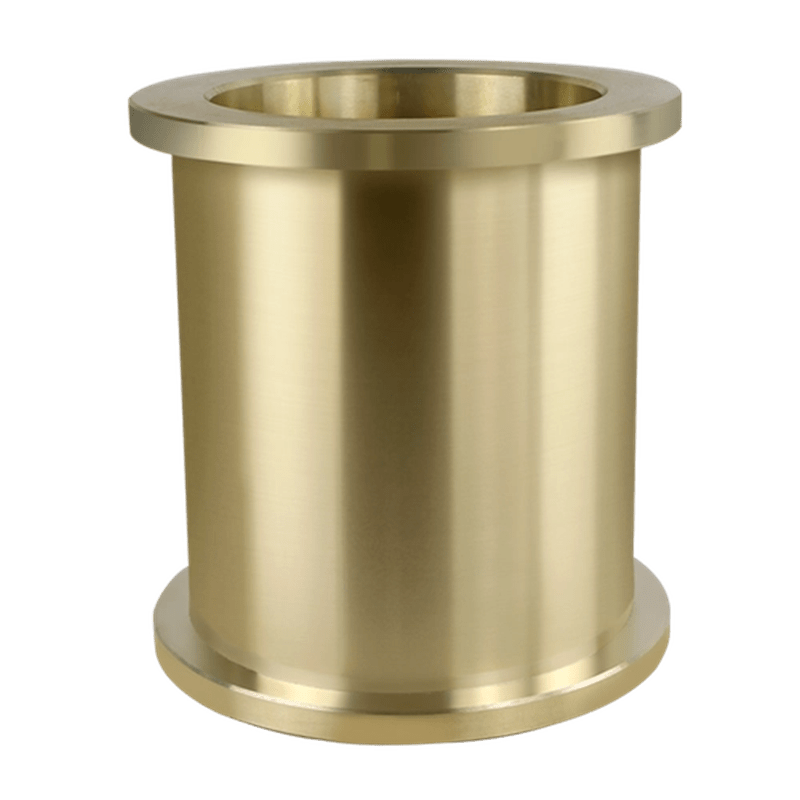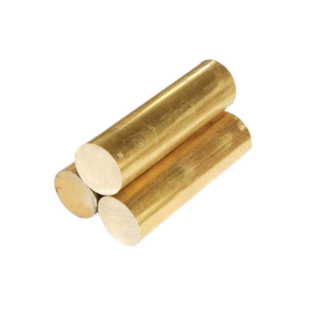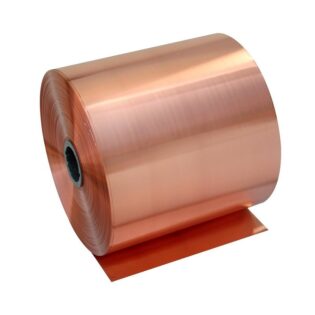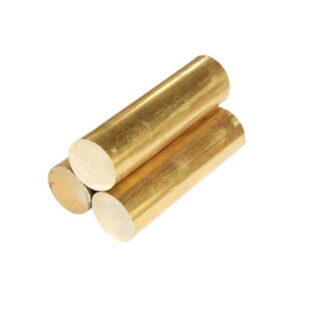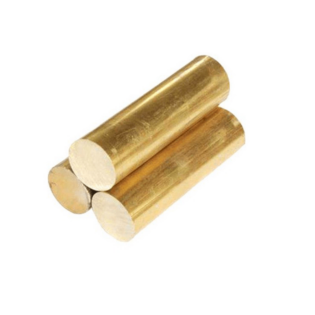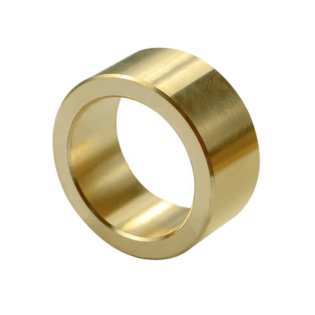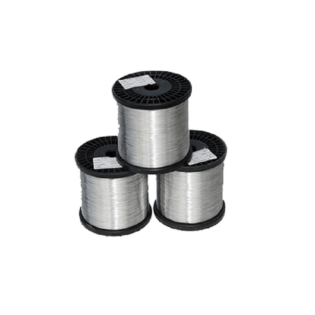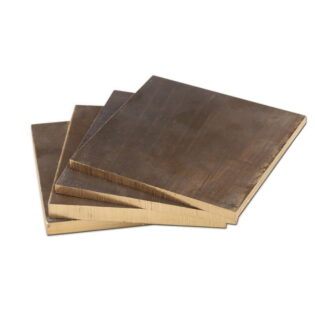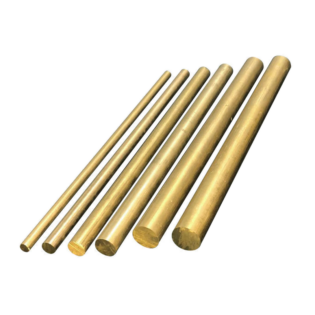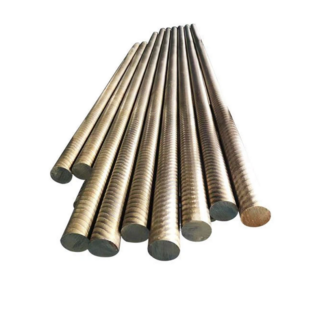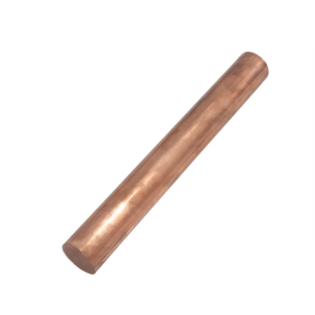AMS 4880-C95510 Nickel Aluminum Bronze Product Introduction
Thành phần hóa học
| Yếu tố | Tỷ lệ phần trăm (%) | Role in the Alloy |
|---|
| Với | 78,00 phút | Primary constituent, provides base structure and properties |
| lò xo kết nối | 0tối đa 0,20 | Improves corrosion resistance and strength |
| Zn | 0tối đa 0,30 | Enhances strength and acts as a deoxidizer |
| Fe | 2.00-3.50 | Refines grain structure and increases strength |
| Ni | 4.50-5.50 | Improves corrosion resistance and mechanical properties |
| Al | 9.70-10.90 | Forms intermetallic compounds, enhancing strength and wear resistance |
| Mn | tối đa 1,50 | Improves strength and deoxidizes the alloy |
Note: Cu + sum of named elements, 99.8% min. Ni value includes Co. Unless otherwise noted, single values represent maximums.
Tính chất cơ học
| Tài sản | Castings <4.0, Heat Treated | Castings 4.0+, Heat Treated |
|---|
| Độ bền kéo, tối thiểu | 105.0 ksi (724 MPa) | 95.0 ksi (655 MPa) |
| Yield strength (0.2% Offset), min | 62.5 ksi (431 MPa) | 56.0 ksi (386 MPa) |
| Elongation in 4D, min | 9% | 9% |
| brinell độ cứng | 192 to 248 BHN | 192 to 248 BHN |
Hiệu suất ở nhiệt độ khác nhau
| Phạm vi nhiệt độ | Đặc tính hiệu suất |
|---|
| Low Temperatures (-50°C to 0°C) | Maintains good ductility and toughness |
| Room Temperature (20°C to 25°C) | Optimal balance of strength and ductility |
| Moderate Temperatures (100°C to 200°C) | Retains good hardness and wear resistance |
| Elevated Temperatures (200°C to 300°C) | Slight decrease in strength, but maintains good corrosion resistance |
| High Temperatures (300°C to 400°C) | Reduced mechanical properties, but still usable in some applications |
Ứng dụng công nghiệp
| Ngành công nghiệp | Specific Applications |
|---|
| Không gian vũ trụ | Landing gear bushings, bearings in aircraft structures |
| Hàng hải | Propellers, pump impellers, valve components in seawater systems |
| Dầu khí | Offshore platform components, subsea equipment |
| Ô tô | Bushings in suspension systems, gearbox components |
| Máy móc công nghiệp | Wear plates, bushings in heavy machinery |
| Mining | Pump components, conveyor system parts |
| Sản xuất điện | Turbine components, valve seats in power plants |
Hình dạng và kích thước sẵn có
| Mẫu đơn | Phạm vi kích thước | Ghi chú |
|---|
| chất rắn | 1/2" đến 9" OD | - |
| Ống | 1 1/8″ to 13″ O.D. | Consult mill for wall thickness |
| Hình chữ nhật | Lên đến 15" | - |
| Standard lengths | 24″ | Consult mill for other lengths |
| Bar Stock | Various diameters | Available in round, hexagonal, and square shapes |
| Đĩa ăn | Up to 6″ thick | Width and length vary by thickness |
| Sự rèn luyện | Custom sizes | Made to order based on specifications |
Tiêu chuẩn sản xuất
| Tiêu chuẩn | Sự miêu tả |
|---|
| AMS 4880 | Aerospace Material Specification for Nickel Aluminum Bronze |
| ASTM B150 | Standard Specification for Aluminum Bronze Rod, Bar, and Shapes |
| ASTM B171 | Standard Specification for Copper-Alloy Plate and Sheet for Pressure Vessels, Condensers, and Heat Exchangers |
| SAE J461 | Wrought Copper and Copper Alloy Heat Exchanger Tube |
| MIL-B-21230 | Military Specification for Bronze, Aluminum |
Standards and Corresponding Grades in Different Countries
| Quốc gia/Khu vực | Tiêu chuẩn/Lớp | Equivalent Designation |
|---|
| Hoa Kỳ | AMS 4880-C95510 | UNS C95510 |
| Châu Âu | EN 1982-CC333G | CuAl10Ni5Fe4 |
| Nhật Bản | JIS H5120-CAC703 | - |
| Trung Quốc | GB/T 5231-QAl9-4 | - |
| Nga | GOST 493-79 Grade BrA9Zh4N4 | - |
| Ấn Độ | IS 3091 Grade 2 | - |
| Châu Úc | AS 2074-CA953 | - |
Welding, Processing, Polishing, Heat Treatment, Cold Processing
Hàn
| Welding Method | Sự phù hợp | Ghi chú |
|---|
| Gas Tungsten Arc Welding (GTAW/TIG) | Xuất sắc | Preferred method for high-quality welds |
| Gas Metal Arc Welding (GMAW/MIG) | Tốt | Suitable for larger components |
| Shielded Metal Arc Welding (SMAW) | Hội chợ | Can be used but not preferred |
| Electron Beam Welding | Xuất sắc | For precision welding in aerospace applications |
| Friction Stir Welding | Tốt | Emerging method for solid-state joining |
Xử lý
| Phương pháp xử lý | Đánh giá khả năng xử lý | Ghi chú |
|---|
| Quay | 50 (0-100 scale) | Use carbide tools for best results |
| Phay | 50 (0-100 scale) | Moderate cutting speeds recommended |
| Khoan | 50 (0-100 scale) | Use high-speed steel or carbide drills |
| Mài | Tốt | Suitable for achieving tight tolerances |
| Electrical Discharge Machining (EDM) | Xuất sắc | For complex shapes and profiles |
Đánh bóng
| Polishing Method | Finish Achievable | Ghi chú |
|---|
| Mechanical Polishing | Mirror finish | Use progressively finer abrasives |
| Electro-polishing | High luster | Suitable for complex geometries |
| Buffing | High shine | Final step for decorative applications |
Xử lý nhiệt
| Heat Treatment Process | Phạm vi nhiệt độ | Purpose |
|---|
| Solution Annealing | 870-900°C | Homogenize microstructure |
| Dập tắt | Rapid cooling to room temperature | Increase strength and hardness |
| Lão hóa | 350-400°C for 2-4 hours | Improve mechanical properties |
| Giảm stress | 350-400°C for 1-2 hours | Reduce internal stresses |
Chế biến lạnh
| Cold Processing Method | Effect on Material | Các ứng dụng |
|---|
| Cold Rolling | Increases strength and hardness | Sheet and strip production |
| Cold Drawing | Improves surface finish and dimensional accuracy | Wire and tube production |
| Rèn nguội | Tăng cường tính chất cơ học | Near-net shape components |
Advantages and Disadvantages of Materials
Thuận lợi
| Thuận lợi | Sự miêu tả |
|---|
| Cường độ cao | Excellent tensile and yield strength compared to many other copper alloys |
| Hao mòn điện trở | Superior resistance to abrasion and galling |
| Chống ăn mòn | Good resistance to seawater and many chemicals |
| Dẫn nhiệt | Better than stainless steels, suitable for heat exchange applications |
| Non-sparking | Safe for use in explosive environments |
| Low Magnetic Permeability | Suitable for applications requiring non-magnetic materials |
Nhược điểm
| Điều bất lợi | Sự miêu tả |
|---|
| Tốc độ dao động từ bảy mảnh mỗi phút đối với máy âm lượng thấp đến | More expensive than simpler copper alloys or steels |
| Trọng lượng | Heavier than aluminum alloys, which may be a concern in some applications |
| Complex Processing | Requires careful control during casting and heat treatment |
| Limited Ductility | Less ductile than pure copper or some other copper alloys |
| Potential for Stress Corrosion Cracking | Can occur under certain environmental conditions |
Sản phẩm tương tự và so sánh
Similar Nickel Aluminum Bronze Alloys
| Nó có tính dẫn điện tốt và chống ăn mòn | Thành phần hóa học | Sự khác biệt chính |
|---|
| C95800 | Cu-9Al-4Fe-4Ni | Higher iron content, slightly lower strength |
| C95700 | Cu-11Al-3Fe-5Ni | Higher aluminum content, increased hardness |
| C95400 | Cu-11Al-4Fe | No nickel, lower corrosion resistance |
Comparison with Other Material Classes
| Vật tư | Advantages over C95510 | Disadvantages compared to C95510 |
|---|
| Stainless Steel 316 | Lower cost, higher availability | Lower thermal conductivity, higher weight |
| Aluminum Bronze (e.g., C95400) | Lower cost, easier to cast | Lower strength and corrosion resistance |
| Đồng phốt-pho | Better electrical conductivity | Lower strength and wear resistance |
| Titanium Alloys | Lower density, higher strength-to-weight ratio | Much higher cost, more difficult to machine |
Detailed Comparison Table
| Tài sản | AMS 4880-C95510 | Stainless Steel 316 | Aluminum Bronze C95400 | Titan lớp 5 (Ti-6Al-4V) |
|---|
| Độ bền kéo (MPa) | 655-724 | 515-690 | 586-758 | 895-930 |
| Sức mạnh năng suất (MPa) | 386-431 | 205-310 | 241-379 | 828-910 |
| Độ giãn dài (%) | 9 (min) | 40 | 12 | 10-15 |
| Mật độ (g/cm³) | 7.64 | 8.00 | 7 giờ 45 | 4,43 |
| Độ dẫn nhiệt (W/m·K) | 42 | 16.3 | 59 | 6.7 |
| Corrosion Resistance in Seawater | Xuất sắc | Xuất sắc | Tốt | Xuất sắc |
| Machinability (0-100 scale) | 50 | 50 | 60 | 30 |
| Relative Cost | Cao | Vừa phải | Vừa phải | Rất cao |
Additional Properties and Characteristics
| Tài sản | Giá trị | Units |
|---|
| Điện trở suất | 14.4 | µΩ · cm |
| Nhiệt dung riêng | 0.375 | J/g·°C |
| Phạm vi nóng chảy | 1030-1060 | ° C |
| Mô đun đàn hồi | 110-120 | GPa |
| Tỷ lệ Poisson | 0.33 | - |
| Fatigue Strength (10⁷ cycles) | 207-241 | MPa |
| Damping Capacity | Vừa phải | - |
Environmental and Recycling Considerations
| Diện mạo | Sự miêu tả |
|---|
| Khả năng tái chế | Highly recyclable, can be remelted and reused |
| Tác động môi trường | Lower energy requirement for recycling compared to primary production |
| Toxicity | Non-toxic in solid form, but dust and fumes during processing should be controlled |
| End-of-Life | Can be collected and recycled through established metal recycling streams |
Quality Control and Testing Methods
| Phương pháp kiểm tra | Purpose | Tiêu chuẩn |
|---|
| Tensile Testing | Determine strength and ductility | ASTM E8 |
| Hardness Testing | Measure surface hardness | ASTM E10 (Brinell) |
| Phân tích hóa học | Verify composition | ASTM E478 |
| Ultrasonic Testing | Detect internal defects | ASTM E114 |
| Radiographic Testing | Inspect for porosity and inclusions | ASTM E1742 |
| Corrosion Testing | Evaluate corrosion resistance | ASTM G31 |
Storage and Handling Recommendations
| Diện mạo | Recommendation |
|---|
| Storage Environment | Dry, clean area away from chemicals |
| Handling | Use appropriate lifting equipment for heavy pieces |
| Protection | Apply protective coatings or wraps to prevent surface damage |
| Inventory Management | Use FIFO (First In, First Out) system to manage stock |
| Safety Precautions | Wear appropriate PPE when handling, especially during cutting or machining |
Typical Lead Times and Pricing Factors
| Nhân tố | Sự miêu tả |
|---|
| Standard Stock Sizes | Usually available with 1-2 week lead time |
| Custom Sizes/Shapes | May require 4-8 weeks lead time |
| Quantity | Larger orders may have longer lead times but better pricing |
| Market Conditions | Copper and nickel prices can significantly affect final cost |
| Certification Requirements | Special certifications may increase lead time and cost |
Phần kết luận
AMS 4880-C95510 Nickel Aluminum Bronze is a high-performance alloy that offers an excellent combination of strength, wear resistance, and corrosion resistance. Its versatility makes it suitable for a wide range of applications across various industries, particularly in marine and aerospace environments. While it may have a higher initial cost compared to some other materials, its long-term performance and durability often result in lower lifecycle costs for critical components. The material’s ability to maintain its properties under diverse operating conditions, coupled with its non-sparking characteristics, makes it a preferred choice for safety-critical applications. As with any specialized material, proper consideration should be given to design, processing, and maintenance to fully leverage its capabilities and ensure optimal performance throughout its service life.
